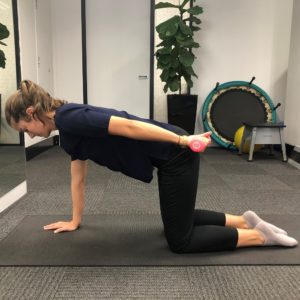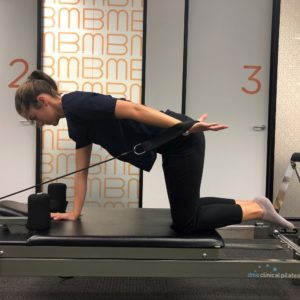In this blog we are going to follow on from the previous ‘Pilates Reformer vs Mat Exercise’ blog and give you a Four-point kneeling arm exercise which can be done on both the mat and the reformer.
Set up:
Hands directly underneath shoulders and knees directly underneath hips. First, we will find your neutral spine by doing a few pelvic tilts. Pelvic tilts involve tucking your tailbone and rounding your lower spine and then lifting your tailbone and dipping your lower spine down. Neutral is roughly halfway between the two movements so you have a little dip in your lower spine. Then we will set your shoulder blades. To do this we move your chest up and pull the shoulder blades apart and then drop your chest to pinch the shoulder blades together. You should feel your shoulder blades moving around your rib-cage. To set the shoulder blades lift the chest so your shoulder blades are apart and pull them down your rib-cage away from your ears.
The Movement:
For both the mat and the reformer you need to keep your set body position still as you move one upper arm. This is one of the challenges of this position.
Mat: On the mat you will use a hand weight in one hand. This weight is lifted up to your hip using your latissimus dorsi on your back and triceps on the back of the arm. Whilst the arm with the hand weight seems to be doing the work here, you should also feel your opposite shoulder muscles working to keep the connection to your rib-cage which we set up at the start. Your deep abdominal muscles then work to stabilise across your neutral lumbar spine.
 Reformer: On the reformer this exercise will use the hand strap attached to the pulley system. The same movement will occur as the exercise on the mat however due to the dynamic movement of the reformer your opposite shoulder and deep abdominal muscles will have to work harder to stabilise you. This is because the reformer surface which you are kneeling on is moving against a spring resistance so therefore you need to use more stability muscles to keep that set up position we started with.
Reformer: On the reformer this exercise will use the hand strap attached to the pulley system. The same movement will occur as the exercise on the mat however due to the dynamic movement of the reformer your opposite shoulder and deep abdominal muscles will have to work harder to stabilise you. This is because the reformer surface which you are kneeling on is moving against a spring resistance so therefore you need to use more stability muscles to keep that set up position we started with.
 This is just one example of an exercise which can be done on both the mat and reformer. Keep a look out on the Bend + Mend blog page to see some more examples.
This is just one example of an exercise which can be done on both the mat and reformer. Keep a look out on the Bend + Mend blog page to see some more examples.
If you would like a personalised physiotherapy exercise program using this clinical pilates equipment come in for an assessment with one of our Bend + Mend Physios today.





